
12 minute read
Daniel Caesar: Case Study 01
DANIEL CAESAR: CASE STUDY 01
One of Canada’s most successful independent artists, Daniel Caesar embarks on an intimate global tour, supported by a core crew of creatives, as TPi’s Jacob Waite discovers…
Following his GRAMMY Award-winning breakout album, Freudian in 2017, the wholly independent Toronto-born singer-songwriter has collaborated with Pharrell Williams, John Mayer and Jacob Collier, to name but a few. As well as receiving critical acclaim, Caesar has garnered the plaudits of fellow Canadians, Shawn Mendes and Justin Bieber – the latter witnessed regularly at a string of the singer’s sold-out, hometown shows in recent years. Returning to centre stage with his follow-up album and worldwide tour, CASE STUDY 01, Caesar brings international concert goers closer than ever before…
PRODUCTION A staple of the DC touring camp, Mike Rowland linked up with Daniel Caesar during the height of the artist’s acescent, during his first wave of GRAMMY Award nominations. Two years on, the Tour Manager and Monitor Engineer told TPi his story. “When I first came in, I was doing monitors, gradually assuming the PM role, before transitioning to a TM role. As a TM, PM and Monitor Engineer, I was keeping incredibly busy as he quickly gained more popularity. Having a good professional dynamic of on-stage mixing and off-stage managing, there came a point where I was stretched and the team needed to expand so I could focus on the TM role.” Rowland’s first appointment as TM was to bring in long-time friend and successor to the PM mantle, Karen ‘Keeks’ Weigold. Having known each other for a number of years, this venture marked the first time the duo had toured together. “This is the first time I’ve been on tour and not mixed,”
Keeks began. “It’s been a strange adaptation process, as I’m so used to being behind the console and wearing multiple hats. However, there are so many moving parts as DC’s PM that I’m never lacking for something to do.” Their suppliers of choice comprised audio vendor, PRG as well as lighting and video vendor, Solotech in the US and Canada. In the UK and Europe, Eighth Day Sound, Video Screen Services (VSS) and Christie Lites provided the touring tech and video personnel. While 24/7 Productions added show design expertise. “I have a longstanding relationship with PRG, particularly Erik Paquette and Randall Knight from the Toronto branch. I met Erik when we were both roughing it and figuring out our paths in the industry, so PRG has always been an ally of sorts,” Keeks reminisced. “They’ve always been incredibly accommodating and helpful, and I know that if I need to make a lastminute change or have a replacement sent to me, they’ll come through 100% of the time,” he commented. “Having that trust and reliability is so important when time is against you. The packaging is also a big benefit; it’s streamlined and condensed without compromising on organisation or our needs. This is a big asset when a few cases could be the difference between how many trucks you need to have on the tour.” This tour marked Keeks’ first time directly involved with visual supplier, Solotech. “Our Account Manager, Robert Kennedy, has been great to work with and always comes through for our visual needs. It’s been a really pleasant tour and I never need to worry if something is going to get done.” The PM recounted the biggest challenge of this tour was having to fit the

scale of the production into a wide variety of spaces, as well as factoring in venue limitations in terms of power, structural integrity and sightlines. “We ended up having to create not only a B rig, but also a C and D version, to be versatile enough without compromising the overall look and feel of the show,” Keeks commented. Despite making sacrifices in some of the smaller spaces, Keeks assured the “heartbeat of the show” remained intact – with the help of a few “visual cheats”, which allowed the crew to maintain the creative integrity. Th e European leg of the tour presented a particular challenge, due to the generally smaller venues compared to North America. “A lot of the places we’re about to go into are not equipped for the scale of our show, so we’ve come up with an alternate design that will still deliver the overall creative vision in a way that’s realistic for where we’re performing. It requires a little compromise, but the overall vision is still strong.”
VISUALS Show Designer, Louis Oliver was brought in to devise the aesthetic elements of the show, with 24/7 Productions’ Andrew Thornton and Andrew Dobbins. The brief was simple: “Management wanted the band to be upstage of gauze that was then projected upon. We built a show around those parameters,” commented Oliver. Management explained how it saw the projection being used, and how it should be placed. Oliver said: “The style is projected image, comprising background images of Daniel and missing vocalists. We’ve repurposed some of his unused assets for the live setting.” Keen to keep the singer as the focal point, Oliver designed a staggered stage to create a 3D visual look.
Refreshingly for the Show Designer, Daniel Caesar adopted a hands-on approach. “He was quite involved in the process since entering rehearsals – the fine-tuning of each of the songs in terms of the lighting programming and where the video content came in and out. He was keen to accent certain parts of songs visually, because he’s a very musical individual.” The gauzes were used throughout the show as a projection surface as well as a backdrop for lighting, with silhouettes of the band among the landmark looks. “It’s an interesting integration because lighting and projection aren’t running side by side, as they do in other shows; one track might be a heavy lighting song, while another is heavy projection.” This is where the scrim came into play. When backlit, the band members behind the projection veil were transformed from 6ft performers into 15ft-tall silhouettes. Ten Robe BMFL Spots were placed 10ft above the performers; the spread of the fixtures allowed Oliver to accentuate the musicians’ size with clever shadow play. Oliver highlighted the varying venue sizes, purposing an A rig for mainland UK, which comprised projection with shark tooth scrim, using a kabuki to reveal the band towards the conclusion of the set. For Europe, because the team encountered logistical issues with projection throws, a video wall upstage was drafted in. Oliver said: “The reason we initially opted for projectors is because we wanted to portray an image as punchy as a high-resolution video wall.” To ensure there was a variable rig which could keep its consistency despite being scaled to fit into the various differently sized venues, six Barco UDX-4K32s were specified. “We needed a lot more luminosity from our projectors, so we decided to up the quality of the projectors to make


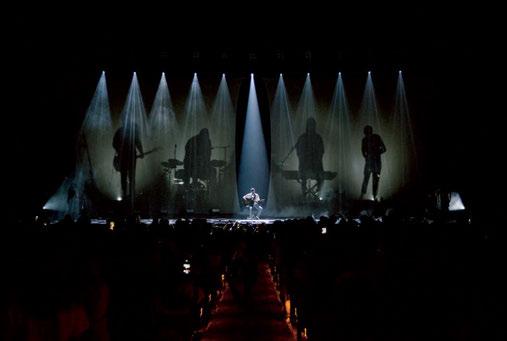
the show brighter. This allowed the band to be seen behind, when deemed necessary for an artistic touch.” Lighting Director, James Moore of Red Rover Entertainment, picked up the story: “Conceptually, it’s very different to other projects that I’ve worked on. It’s not a traditional, three-stick rock ’n’ roll show. The projection and video content are a lot heavier than other shows we’ve worked on.” Moore was also involved in the projection elements, hanging them during flown shows, controlling the content and making sure the lighting didn’t overwhelm the projection. “These two elements run independently, alongside each other to create a final look. Every song is complemented by the content, creatively throughout – it’s a continuous cycle, which is nice. Louis has devised an overall show design.” For control, a pair of MA Lighting grandMA2 lights were situated at FOH, with grandMA2 NPUs. Video content was run via Resolume Avenue VJ Software, while the backbone of the FOH rig boasted MA Network Switch and sACN. “The grandMA2 is my ‘go-to’ console,” Moore mentioned. “I’m sticking with the MA2 for now before making the eventual leap to MA3.” Half timecoded, half manually operated to factor in guest appearances, Moore walked TPi through his approach. “It’s been an interesting task,” he began. “I typically fill the shoes of the lighting operator/system tech, so operating a show where I have to hit cues is refreshing,” he explained. “I wasn’t prepared for that. It was supposed to be entirely timecoded but having to adjust and having the freedom to do that and learning from Louis has been brilliant.” Mo ore also had to account for setlist fluctuation. “Ultimately, it’s down to the production elements we’re putting into the show, which can dictate
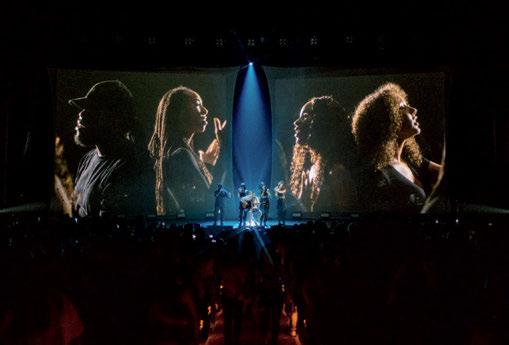
the setlist, along with the scale,” he acknowledged. “When we’re going into the bigger markets, we’ll often have guest performers, which is where the biggest fluctuation happens – that’s why some songs aren’t timecoded, with Louis anticipating that other performers would join the tour.” Caesar’s hometown shows in Toronto altered drastically in scale, audience and production, with guest artists collaborating on multiple songs. “Daniel was really vibing with the crowd,” recalled Moore. “The end of his set is where I get the most playtime because he breaks into an acoustic set, with one or two encore songs. Other nights, it could be 20 or 30 minutes – he keeps me on my toes. However, being a Canadian, it’s refreshing to work with a hometown artist.” Th e lighting rig comprised 10 GLP JDC1s, 15 Robert Juliat Dalis 862s and Molefay 4 Lites. To set the scene, four MDG ATMes with external fans joined a pair of Martin by Harman Low Foggers. A total of 19 Ayrton Mistral-S’ generated the overall aesthetic. “Everything stems from them,” Moore gestured to the fixtures housed in a row. “They’re doing the vast majority of the legwork for the show – especially the big audience looks.” Additional Mistral-S’ were also used for front light, effects and hits. “They’re a great fixture!” the LD exclaimed. The other big aesthetic fixtures were seven Robe BMFL Washbeams, used primarily as backlight. “During an acoustic number, we typically have one centre light on Daniel. It’s a powerful fixture, with gobos and an unparalleled beam spread.” Moore praised the tour’s lighting supplier. “Solotech has been fantastic; they’re a native company and I’ve worked with them a bit.” In Europe, VSS facilitated the fixture side of lighting, using the logistical elements of
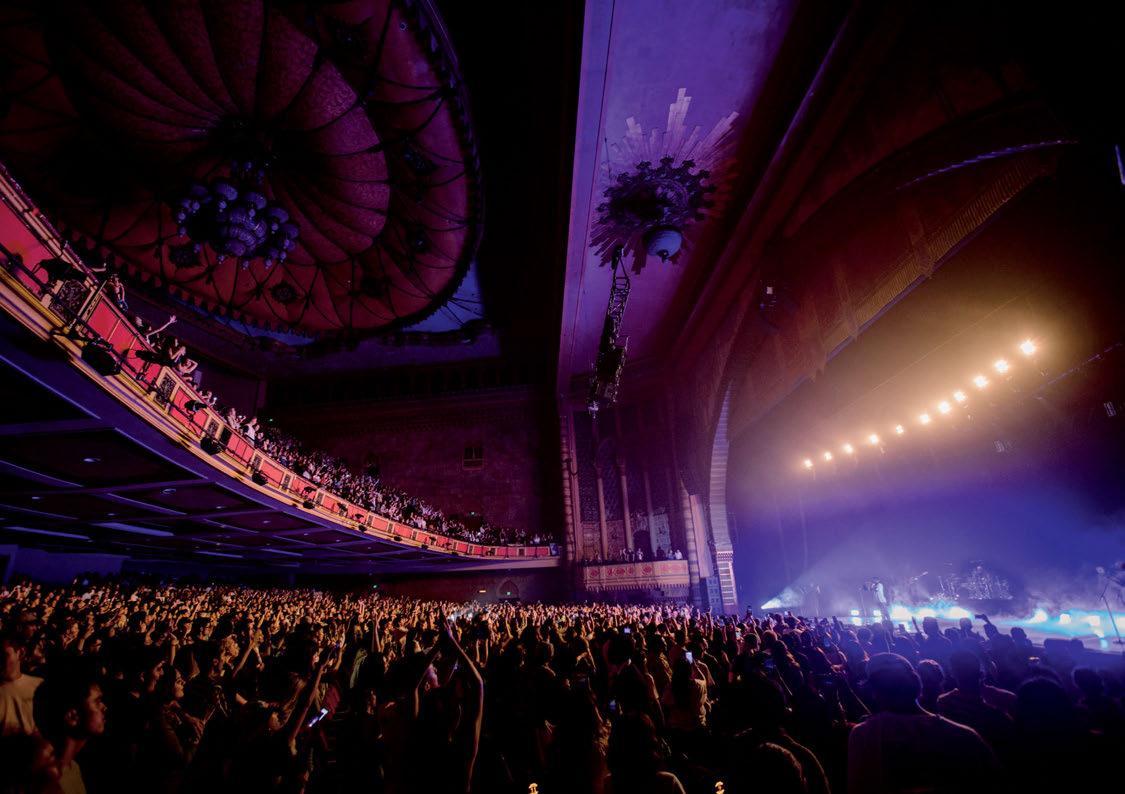
Christie Lites to create a nice balance. “I’m so used to Christie Lites as a Canadian company – their logistical and management of gear is amazing,” Moore commented. “The shop in Coventry looked exactly like the Toronto shop. It’s easy to move around and the systems are seamless.” Summing up his time on the tour, Moore concluded: “It’s been interesting and enjoyable to play a scale of venues, from 1,000-capacity clubs, hanging a few lights with the floor package pulling the weight, all the way to 16,000-capacity outdoor open-air venues. I’ve really enjoyed the mix and rising to the challenge of making the show look good in those wide range of venues. Hats off to Louis and the 24/7 Productions team for putting together a rig and team flexible enough to do that.”
AUDIO Having toured with the likes of AFI, Don Broco, Theory of a Deadman, Black Stone Cherry and Marianas Trench, Monitor Engineer, Mike Rowland took on a fresh set of sonic challenges working with Daniel Caesar. “It’s interesting on an audio front as we have so many potential guests,” he began. “Any special guest that features on the album and is in town could always join Daniel on stage, so it’s my job to ensure everything is as polished as possible. It keeps me on my toes.” In monitor world, Rowland mixed on an Avid S6L with Waves plug-ins including NLS, C6, SSL, API2500, BSS402, plus a number of others. As the team didn’t carry PA, PRG provided consoles and all control in the US and Canada, while Eighth Day Sound filled in for the UK and EU legs of the tour. FOH Engineer, Cameron Mclellan also mixed on an Avid S6L: “The way Avid lays out its consoles has always been great for me intuitively, as I’ve
used Pro Tools for roughly 15 years,” he commented. “The workflow of everything just makes sense. I’ve always liked walking up to SC48s/Profiles on the road for that reason – especially if I’m dialling in something from scratch. The S6L is a nice natural upgrade from that. We didn’t use any outboard gear for this run. Everything I use is stock with the S6L.” Before working with Daniel Caesar, Mclellan primarily mixed metal/hard rock live, bringing a set of transferable principles over to his live show. “The drums are the foundation of my mix,” he asserted. “They are what I get most comments on when people hear the show live.” For an R&B artist, you may expect to hear duller less overt drums to cater to the more laid-back energy generally associated with this sort of music. However, “in reality, if you listened to my drum mix for Daniel compared with any of the metal guys I used to mix, you wouldn’t find too much of a difference sonically – smooth overheads and punchy shells being the base of the mix.” The most important part of Mclellan’s mix was ensuring Caesar’s vocals sat “nicely on top of everything”. He commented: “Daniel’s got an insane amount of low-mid information in his voice, so he’s high-passed unusually high for the most part, changing from room to room. Throw in a few reverbs and a couple of FX throws and that’s the meat and potatoes of it all.” With 12 wireless mics and 14 in-ear mixes, coordination came in the shape of 14 Shure PSM 1000s, 16 Sennheiser 6000 RF mics and four Shure UR4Ds for backline wireless. “Having bounced around a few brands, we’ve found that the Sennheiser mics stay true to his voice and have a great rejection pattern,” Rowland said. The extensive mic kit included Telefunken M82s, Telefunken M80s,

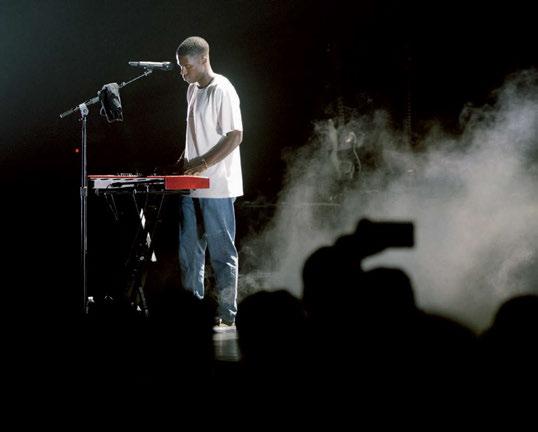
Telefunken M81s, Beyerdynamic M88s, BeyerDynamic TGD58Cs, as well as Neumann 184s and 102s. “It’s my personal package, which I love,” commented Rowland. Mclellan furthered: “Mike’s mic kit has been a consistent part of our live sound ever since I brought him on board in 2017 – Telefunken on the snares and kick, Sennheiser on the toms, Neumann on the overheads and hats and guitars with a couple of other trinkets in the mix. I don’t always have my own console, so having consistent microphones is a nice baseline to have as a minimum.” The FOH Engineer explained that, with having a consistent FOH board and array of microphones every day, the transitions between each room have been fairly smooth, only having to tune whatever the PA of that day is to coordinate with what he is trying to get out of the mix. “It’s been fairly headache-free,” he noted. With only four channels of wireless instruments to account for in backline world, the setup was clean, with no wedges. Rowland explained: “Everybody is on Ultimate Ears UE18s or UE-Lives – the latter used for Daniel’s mix. I’ve grown to really enjoy the Lives and we have had great support from Jeanette at UE.” By contrast, Mclellan told TPi that the Daniel Caesar team has gone from one crew person to two busses, which will now become two semis and trailers. “It’s been a successful tour on every front and it’s going to carry on as we’re adding more content shot by artists that appear on the album,
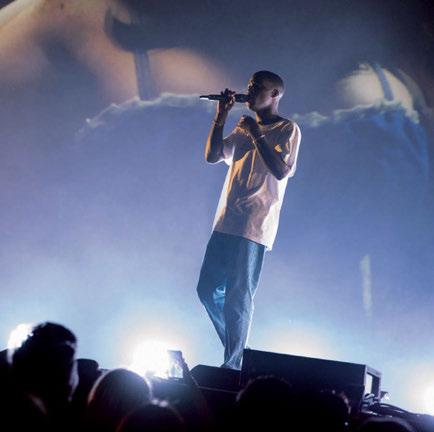
so the show is growing as the tour is going on, which is great.” Marking the largest Daniel Caesar production to date, in terms of both production and personnel, the rhythm was set very early on in the tour and continued like a well-oiled machine for the remainder of the run. Mclellan supposed: “With Mike Rowland in monitor world, Meaghan McEachren as our A2 [Rowland dubbed McEachren as “the most important person” to his delivery of the show] and Karen ‘Keeks’ Weigold as our PM, we are in very good hands all around.”
CO NCLUSION Live, Daniel Caesar’s performance is intimate and dreamy, ebbing and flowing between waves projection scrim, considered lighting and ambitious sound design. Rowland summed up: “He is an artist who has gained a lot of success in remaining independent, he is and will continue to do well, so it’s fantastic to be part of something which shows no signs of slowing down.” TPi Photos courtesy of 24/7 Productions. www.danielcaesar.com www.24-7productions.co.uk www.prg.com www.solotech.com www.8thdaysound.com www.videoscreenservices.com


